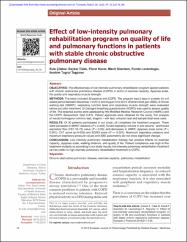| dc.contributor.author | Çilekar, Şule | |
| dc.contributor.author | Tülek, Baykal | |
| dc.contributor.author | Kanat, Fikret | |
| dc.contributor.author | Süerdem, Mecit | |
| dc.contributor.author | Levendoğlu, Funda | |
| dc.contributor.author | Taşpınar, İbrahim Tuğrul | |
| dc.date.accessioned | 2021-05-05T22:16:57Z | |
| dc.date.available | 2021-05-05T22:16:57Z | |
| dc.date.issued | 2019 | |
| dc.identifier.issn | 2148-3620 | |
| dc.identifier.issn | 2148-5402 | |
| dc.identifier.uri | https://doi.org/10.4103/ejop.ejop_16_19 | |
| dc.identifier.uri | https://app.trdizin.gov.tr/makale/TXpNd01UQTVPUT09 | |
| dc.identifier.uri | https://hdl.handle.net/20.500.12933/493 | |
| dc.description.abstract | OBJECTİVES: The effectiveness of low-intensity pulmonary rehabilitation program applied patients with chronic obstructive pulmonary disease (COPD) in terms of exercise capacity, dyspnea scale, life quality and respiratory muscle strength. METHODS: The study included 30 patients with COPD. The program was 3 days in a week, for a 6 weeks period between December 1st 2012 and August 31st 2013. Arterial blood gas (ABG), 6 minute walking test (SMWT), respiratory function tests and respiratory muscle strength were evaluated before and after treatment. St George's breathing questionnaire (SGRQ) was used to assess quality of life. The dyspnea scores were assessed by the Modified Medical Research Council (mMRC) and the COPD Assessment Test (CAT). Patient approvals were obtained for the study. For analysis of results kolmogorov smirnov test, shapiro – wilk test, wilcoxon test and sample ttest were used. RESULTS: Of 30 patients participated in our study, 26 completed the treatment program. There were increases in SMWT distance (P = 0.049), forced expiratory volume in one second , and forced expiratory flow (FEF 25-75) value (P < 0.05); and decreases in mMRC dyspnea scale score (P = 0.001), CAT score (p=0.003) and SGRQ score (P <= 0.001). Maximum inspiratory pressure and maximum expiratory pressure values and ABG parameters did not show significant change. CONCLUSION: Low intensity pulmonary rehabilitation therapy has positive effects on exercise capacity, dyspnea scale, walking distance, and quality of life. Patient compliance was high in this treatment modality so according to our study results, low intensity pulmonary rehabilitation treatment can be prefer to high intensity pulmonary rehabilitation treatment in COPD. | en_US |
| dc.language.iso | eng | en_US |
| dc.rights | info:eu-repo/semantics/openAccess | en_US |
| dc.subject | Solunum Sistemi | en_US |
| dc.title | Effect of low‑intensity pulmonary
rehabilitation program on quality of life
and pulmonary functions in patients
with stable chronic obstructive
pulmonary disease | en_US |
| dc.type | article | en_US |
| dc.department | AFSÜ, Tıp Fakültesi, Dahili Tıp Bilimleri Bölümü, Göğüs Hastalıkları Ana Bilim Dalı | en_US |
| dc.contributor.institutionauthor | Çilekar, Şule | |
| dc.identifier.doi | 10.4103/ejop.ejop_16_19 | |
| dc.identifier.volume | 21 | en_US |
| dc.identifier.issue | 1 | en_US |
| dc.identifier.startpage | 14 | en_US |
| dc.identifier.endpage | 20 | en_US |
| dc.relation.journal | Eurasian Journal of Pulmonology | en_US |
| dc.relation.publicationcategory | Makale - Ulusal Hakemli Dergi - Kurum Öğretim Elemanı | en_US |
















